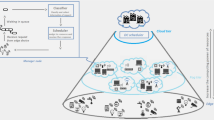Abstract
Load scheduling has been a major challenge in distributed fog computing environments for meeting the demands of decision-making in real-time. This research proposes an quantumized approach for scheduling heterogeneous tasks in fog computing-based applications. Specifically, a node-specific metric is defined in terms of Node Computing Index for estimating the computational capacity of fog computing nodes. Moreover, QCI-Neural Network Model is proposed for predicting the optimal fog node for handling the heterogeneous task in real-time. In order to validate the proposed approach, experimental simulations were performed in different cases using 5, 10, 15, 20 fog nodes to schedule heterogeneous tasks obtained from online Google Job datasets. A comparative analysis was performed with state-of-the-art scheduling models like Heterogeneous Earliest Finish Time, Min–Max, and Round Robin were used for comparative analysis to determine performance enhancement. Better performance was acquired for the proposed approach with execution delay of 30.01s for 20 nodes. In addition to this, high values of statistical estimators like specificity (90.99%), sensitivity (89.76%), precision (91.15%) and coverage (94.56%) were registered to depict the enhancement in overall system performance.





Similar content being viewed by others
References
Bhatia M, Sood SK (2019) Exploring temporal analytics in fog-cloud architecture for smart office healthcare. Mobile Netw Appl 24:1392–1410
Bonomi F, Milito R, Zhu J, Addepalli S (2012) Fog computing and its role in the internet of things. In: Proceedings of the first edition of the MCC workshop on Mobile cloud computing. ACM, pp 13–16
Baccarelli E, Vinueza Naranjo PG, Scarpiniti M, Mohammad S, Abawajy JH (2017) Fog of everything: energy-efficient networked computing architectures, research challenges, and a case study. IEEE Access 5:9882–9910
Nielsen MA, Chuang I (2002) Quantum computation and quantum information. Am J Phys 70:558
Kaur K, Kaur N, Kaur K (2018) A novel context and load-aware family genetic algorithm based task scheduling in cloud computing. In: Satapathy S, Bhateja V, Raju K, Janakiramaiah B (eds) Data engineering and intelligent computing. Springer, Berlin, pp 521–531
Chawla A, Ghumman NS (2018) Package-based approach for load balancing in cloud computing. In: Aggarwal V, Bhatnagar V, Mishra D (eds) Big data analytics. Springer, Berlin, pp 71–77
Belgaum MR, Safeeullah S, Alansari Z, Alam M (2018) Cloud service ranking using checkpoint-based load balancing in real-time scheduling of cloud computing. In: Saeed K, Chaki N, Pati B, Bakshi S, Mohapatra D (eds) Progress in advanced computing and intelligent engineering. Springer, Berlin, pp 667–676
Srivastava S, Singh S (2018) Performance optimization in cloud computing through cloud partitioning-based load balancing. In: Bhatia S, Mishra K, Tiwari S, Singh V (eds) Advances in computer and computational sciences. Springer, Berlin, pp 301–311
Tang Z, Zhang X, Li K, Li K (2018) An intermediate data placement algorithm for load balancing in spark computing environment. Future Gener Comput Syst 78:287–301
Liu Q, Cai W, Shen J, Zhangjie F, Liu X, Linge N (2016) A speculative approach to spatial-temporal efficiency with multi-objective optimization in a heterogeneous cloud environment. Secur Commun Netw 9(17):4002–4012
Li Y, Chen Z, Wang Y, Jiao L, Xue Y (2017) A novel distributed quantum-behaved particle swarm optimization. J Optim 2017:1–9
Dai S, Liwang M, Liu Y, Gao Z, Huang L, Du X (2017) Hybrid quantum-behaved particle swarm optimization for mobile-edge computation offloading in internet of things. In: International conference on mobile ad-hoc and sensor networks. Springer, pp 350–364
Schlegel HB (1982) Optimization of equilibrium geometries and transition structures. J Comput Chem 3(2):214–218
Liu C-Y, Chen C, Chang C-T, Shih L-M (2013) Single-hidden-layer feed-forward quantum neural network based on grover learning. Neural Netw 45:144–150
Shyam GK, Manvi SS (2016) Virtual resource prediction in cloud environment: a Bayesian approach. J Netw Comput Appl 65:144–154
Abdelaziz A, Elhoseny M, Salama AS, Riad AM (2018) A machine learning model for improving healthcare services on cloud computing environment. Measurement 119:117–128
Jitendra Kumar and Ashutosh Kumar Singh (2018) Workload prediction in cloud using artificial neural network and adaptive differential evolution. Future Generation Computer Systems 81:41–52
Pham X-Q, Huh E-N (2016) Towards task scheduling in a cloud-fog computing system. In: 2016 18th Asia-Pacific network operations and management symposium (APNOMS). IEEE, pp 1–4
Basu S, Karuppiah M, Selvakumar K, Li K-C, Hafizul Islam SK, Mehedi Hassan M, Bhuiyan MZA (2018) An intelligent/cognitive model of task scheduling for iot applications in cloud computing environment. Future Gener Comput Syst 88:254–261
Puthal D, Obaidat MS, Nanda P, Prasad M, Mohanty SP, Zomaya AY (2018) Secure and sustainable load balancing of edge data centers in fog computing. IEEE Commun Mag 56(5):60–65
Author information
Authors and Affiliations
Corresponding author
Additional information
Publisher's Note
Springer Nature remains neutral with regard to jurisdictional claims in published maps and institutional affiliations.
Rights and permissions
About this article
Cite this article
Bhatia, M., Sood, S.K. & Kaur, S. Quantumized approach of load scheduling in fog computing environment for IoT applications. Computing 102, 1097–1115 (2020). https://doi.org/10.1007/s00607-019-00786-5
Received:
Accepted:
Published:
Issue Date:
DOI: https://doi.org/10.1007/s00607-019-00786-5




